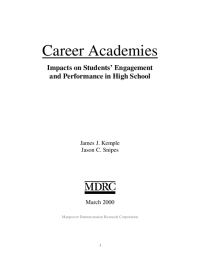Career Academies: Impacts on Student Engagement and Performance in High School
The Career Academy approach is one of the oldest and most widely established high school reforms in the United States. Career Academies have existed for more than 30 years and have been implemented in more than 1,500 high schools across the country. The durability and broad appeal of the Academy approach can be attributed, in part, to the fact that its core features offer direct responses to a number of problems that have been identified in large comprehensive high schools. Career Academies attempt to create more supportive and personalized learning environments through a school-within-a-school structure. Their curricula combine academic and occupation-related course requirements that aim both to promote applied learning and to satisfy college entrance requirements. Academies establish partnerships with local employers to build sequences of career awareness and work-based learning opportunities for their students.
While the basic organizational features of the approach have remained the same since Career Academies’ inception, the goals and target population have changed. The original Academies were designed primarily to prevent dropping out of high school and to increase preparation for work among students who began high school at high risk of school failure. There is now widespread agreement that Career Academies should seek to prepare students for both work and college, and that they should include a broad cross-section of students, including those who are highly engaged in school.
There has been a great deal of research on the Academy approach. Nevertheless, previous studies have been unable to determine reliably whether differences between Academy students’ high school experiences and outcomes and those of other students result from the Academy itself or from the program’s student targeting or its selection practices. Further, little is known about the relative effectiveness of Academies for different groups within the broad cross-section of students they now serve. There have also been few opportunities to explore the extent to which different contexts and implementation strategies may influence the effectiveness of the Academy approach.
This evaluation has demonstrated the feasibility and benefits of using a large-scale, multisite random assignment research design to determine the impact of Career Academies on student outcomes. A rarity in education research, this design provides a uniquely rigorous way of comparing the performance of students who had access to an Academy with the performance of a truly comparable group of students who did not have access to the programs. In order to address a number of key policy issues for Academies and related high school reforms, this report focuses on three questions:
- To what extent does the Career Academy approach alter the high school environment in ways that better support students academically and developmentally?
- To what extent does the Career Academy approach change educational, employment, and youth development outcomes for students at greater or lesser risk of school failure?
- How do the manner and context in which Career Academy programs are implemented influence their effects on student outcomes?
This report marks a milestone in MDRC’s ten-year Career Academies Evaluation, which is being supported by the U.S. Departments of Education and Labor and by 17 private foundations and organizations. The report focuses on over 1,700 students who had applied for one of nine Career Academies participating in the evaluation. The participating Academies were able to implement and sustain the basic features of the approach and have adapted to a wide range of local needs and circumstances. They include a range of technical, service-oriented, and business-related career themes and are located in small cities and large urban school districts. Students in the study sample were identified when they were in 8th or 9th grade, and this report follows them through the end of their scheduled 12th-grade year.







